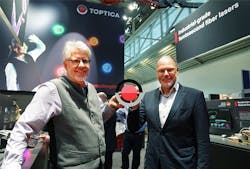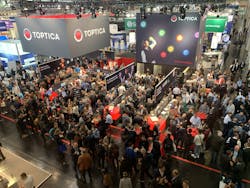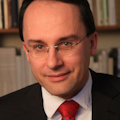Toptica: The evolution of a laser startup to a mature company
In 1998, Toptica Photonics was created with the know-how from Ted Haensch, who was awarded the Nobel Prize a few years later. Today, the Toptica Group employs about 450 people. Unintendedly, it has become a role model for other academic startups converting a technology dream into commercial success. Andreas Thoss speaks with Toptica’s co-founders and Presidents Wilhelm Kaenders and Thomas Renner about the company’s founding and continuing growth.
Laser Focus World: How did you start your company?
Wilhelm: Actually, the company foundation was the second step. I had entered a company—TuiLaser—building excimer lasers for the medical market, and there was hope that diode lasers could add to this. But I brought in ideas instead for scientific lasers. I called my former colleagues from university and offered them: why don’t you buy what you build yourself today?
A fun fact is that we did not start in a garage, but a bathroom. The bathtub of a small flat was our first storage area. We had a few prospective customers mainly in Japan and Korea plus a German research project on long-distance interferometry where our lasers were integrated.
LFW: How did you expect it would grow?
Wilhelm: We had the dream of having a 5 million Deutschmark—now €2.5 million—turnover within five years. We were very brave, we thought, with this ambitious goal. Then, things went on more quickly due to rather unexpected circumstances. On the one hand, Nobel Prizes were awarded related to our technology. On the other hand, laser diode companies like SDL left the market, giving us more and separate opportunities.
Besides the scientific market, right at the start in 1998, we entered into the field of test equipment for optical data storage. That brought us close to Nichia. We helped them to get in that market with blue gallium nitride diodes. They bought extremely flexible testing devices from us and, as a sideline of this feat, we were able to get these novel blue diodes first into scientific products and then into industrial products. It was cross marketing an optical data storage product in the scientific world. Soon, we exceeded our expectations by far. Although now counting in euros [1 Euro = 1.96 Deutschmark], we had more than 5 million after five years.
LFW: Thomas, you joined Toptica coming from Rofin-Baasel, an established large industry entity. Why did you move from a large company to a small one?
Thomas: If you have many ideas and cannot execute them, you get somewhat frustrated and look for other opportunities. By chance, I came into contact with the startup Toptica. I immediately liked the team, their philosophy, and culture. When I entered Toptica in 2005, there were about 50 people and revenues of about €10 million. Today, we are 10 times larger, but still try to retain that culture.
Only now, I need to remember sometimes my own initial motivation. Now I’m the one who needs to listen to the ideas of the young people, and encourage and help them.LFW: Wilhelm, most of the laser companies of Toptica’s size have been sold within the last 20 years. Have you ever thought of an exit?
Wilhelm: Toptica is a dream realized for me and has developed into an extraordinary company during the last 24 years. We have tried to grow the company so it can regenerate on its own in developing ever-new ideas. Sure, we are organizing innovation more than in the past. But in my view, it is still much too early to exit and disappear into a larger entity.
LFW: I think there’s a big difference between pure academic spirit and business in a company. How do you change the minds of young Ph.D.s toward product and business success, without frustrating them?
Wilhelm: We are looking for cutting-edge technology, so our experts often come directly from the university. However, after spending long nights in labs, these people start realizing there are other forms of life. And they see that a company’s profitability is not a bad habit, but the prerequisite for their own creativity and personal development, too. Roles in application, product marketing, and sales support to our highly trained customer base become an option. And, of course, moving up the ranks also brings you out of the lab routine. We established the career path of becoming a Toptica Fellow for those we don’t want to lose their technical roles, while others get group management responsibilities.
Thomas: We have many Ph.D.s, but not all of them come directly from university. Some already have two or three entrepreneurial stations behind them. Everyone who joins the company gets a coach in the initial phase to help them get started. This is perhaps a little different from other companies of a similar size. We realized very early on that you can’t dump everything on the presidents. So, we set up second and third levels, and we don’t even talk much about levels, but about competencies and opportunities. We’re giving them visibility to the outside. We don’t need to have the top leaders always shine over the whole company, but give everybody who contributes enough light to evolve themselves.
LFW: As a medium-sized company, you win with innovation. How do you decide which ideas are worth an investment?
Wilhelm: Initially, the technological vision was clear to me: support and foster the field of cold atoms and ions with the best laser sources available. This is now a substantial part of the so-called Quantum Revolution or Quantum 2.0. We’re able to extend this into other markets like biophotonics or test and measurement.
After nearly 25 years, we organize innovation like any other company in the world—not because we have too few ideas, but too many. Many of them are coming from the outside and require a commitment that we can only give to selected projects. Such a commitment always needs to be shared by the potential market and customer to help set our priorities.
Thomas: It’s a three-step process. First, communicate you’re open to ideas. We call it the green phase, where everything is possible. Also encourage people to think outside of the box. Otherwise, you get standard ideas. Then, in a second more formalized process, everybody needs to sell their idea to a panel. That’s how I think every company is doing something similar. We do it in a quite simple way, just sell it in basic numbers. Third, which is something I actually learned from my personal mentor, Carl Baasel, don’t make things too complicated. Don’t go into last-digit calculations because you're going to miscalculate it anyway within a five years’ forecast. Use simple procedures that start from a gut feeling and end with pure rational arguments.
LFW: Wilhelm, three years ago, we were looking at market opportunities in quantum technology and ended up saying that today it’s just a business-to-government market. Do you see a sustainable market for quantum technology now?
Wilhelm: I think it is too early to make a final judgment there. And I think my comment on a business-to-government market is still valid. Government-funded research is the only one that has the application need. Unfortunately, there might be too much national interest right now and the evolution of quantum technology into broader markets is being hindered by export control and by national priorities. We need to use all of the global intellectual power to make quantum successful.
Thomas: The base technology is quite well developed. The next step is the ease of its use. You have a quantum computer, for example, on an optical table, but in the future you need to have a quantum computer, which is hands-off. That’s the next challenge.
Wilhelm: Are 50 qubits enough, or do we need a thousand? Can we get error correction in place so we don’t need so many qubits just to compensate for environmental effects? Is quantum sensing providing that additional benefit so people are willing to spend money on it? These questions are still difficult to resolve. For quantum, I believe engaging with the global engineering power is a very good step now.
Thomas: Sometimes it looks like a “solution seeking a problem,” but it doesn’t make me nervous because I know how the laser markets evolved.
About the Author
Andreas Thoss
Contributing Editor, Germany
Andreas Thoss is the Managing Director of THOSS Media (Berlin) and has many years of experience in photonics-related research, publishing, marketing, and public relations. He worked with John Wiley & Sons until 2010, when he founded THOSS Media. In 2012, he founded the scientific journal Advanced Optical Technologies. His university research focused on ultrashort and ultra-intense laser pulses, and he holds several patents.


